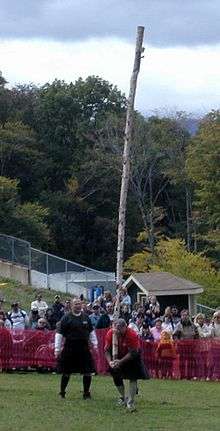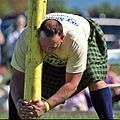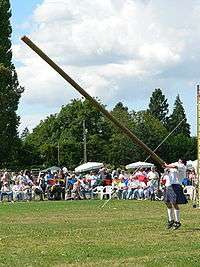Caber toss
 A caber being tossed at the 2000 New Hampshire Highland Games | |
| Presence | |
|---|---|
| Country or region | Scotland |
| Olympic | No |
The caber toss is a traditional Scottish athletic event in which competitors toss a large tapered pole called a "caber". It is normally practised at the Scottish Highland Games. In Scotland the caber is usually made from a Larch tree and is typically 19 feet 6 inches (5.94 m) tall and weighs 175 pounds (79 kg). The term "caber" derives from the Gaelic word cabar, which refers to a wooden beam.
The person tossing the caber is called a "tosser" or a "thrower".[1]
It is said to have developed from the need to toss logs across narrow chasms (in order to cross them), lumberjacks needing to transport logs by throwing them in streams,[2] or by lumberjacks challenging each other to a small contest.
The record for most caber tosses in 3 minutes is currently held by Danny Frame (Canadian). He managed to perform 16 successful caber tosses on 20 July 2018 at the Heart of the Valley Festival in Middleton, Nova Scotia, Canada.[3]
Objective and technique
The primary objective is to toss the caber so that it turns end over end, falling away from the tosser. Ideally it should fall directly away from the tosser in the "12 o'clock" position. The distance thrown is unimportant.
The tosser balances the caber upright, tapered end downwards, against his or her shoulder and neck, the caber being supported by stewards or fellow-competitors while being placed into position. The tosser then crouches, sliding his interlocked hands down the caber and under the rounded base, and lifts it in his cupped hands.
While standing he must balance the caber upright; this is not easy with the heavier end at the top, and less-experienced tossers may be unable to stop the caber falling to one side after lifting it. The tosser then walks or runs a few paces forward to gain momentum, and flips the tapered end upwards so that the large end hits the ground first, and, if well tossed, the caber falls directly away from the tosser.
Weight and strength are clearly essential for success, but technique is also important for balancing the caber when lifting it, and flipping up the held (tapered) end to promote a clean toss.
Scoring
| Wikisource has the text of the 1911 Encyclopædia Britannica article Caber Tossing. |
The straightest end-over-end toss scores highest. If the caber lands on its end but falls back towards the thrower, the score is lower than for any end-over-end throw but is based upon the maximum vertical angle that the caber achieved (side-judging may involve a second judge).
Photo gallery
 A selection of cabers of various lengths and weights
A selection of cabers of various lengths and weights Getting ready to lift
Getting ready to lift The run-up
The run-up Moment of release
Moment of release The caber in mid-flight
The caber in mid-flight The caber strikes the ground
The caber strikes the ground
See also
References
- ↑

- ↑ English, Nick (8 November 2016). "Caber Tossing: Why Hurling Trees Is the Most Delicate Strength Sport". BarBend. Retrieved 20 December 2016.
- ↑ "Danny Frame sets caber toss world record with 16 flips at Middleton festival | The Casket". www.thecasket.ca. Retrieved 2018-07-23.